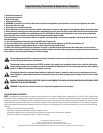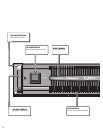
8
FRONT PANEL FEATURES
AC POWER SWITCH
•Controls all power to the amplifier. The AC Switch must be ON to use remote controlled Standby mode. The Blue POWER LED should
illuminate whenever Power is ON, either in Standby or Run.
•On the PL-380, it is normal for the Clip LEDs to remain on for 15 seconds after removing power. The red LEDs indicate prompt muting to
prevent turn-off noises.
CLIP LED (Red, Each Channel).
•The LED glows bright red while amp is muted for any reason. This normally occurs each time the power is turned on or off. Muting at
other times indicates overheating or other protective behavior.
•The LED flashes bright red during clipping. The intensity and duration correlates with the audibility of the clipping.
•The LED glows half-bright during limiting. This may occur on all products when the Clip-Limiting circuit is enabled. The PL380 also uses
limiting to protect against overheating, excessive high frequency output, and prolonged power overload.
-10dB LED (Orange, Each Channel).
•Illuminates when the amplifier channel reaches the last 10dB of its power range (between 10% and 100% of rated power). The LED is
orange to warn that clipping is being approached.
-20dB LED (Green, Each Channel).
•Illuminates when the amplifier channel is 10-to-20dB below clipping (between 1% and 10% of rated power). This should normally be a
“safe” zone of operation.
SIGNAL LED (Green, Each Channel).
•Illuminates when the signal level reaches -35dB, which should produce an easily audible sound in the speakers. If this LED remains illu-
minated when no signal is expected, there may be interference or some other abnormal condition.
POWER LED (Blue)
•The Blue POWER LED should illuminate whenever Power is ON. It may dim visibly when the amp is in Standby.
BRIDGE LED (Yellow)
•Warns that the rear panel Bridge Mode switch has been set. The LED color matches the rear panel readout. See BRIDGE MONO MODE
on next page.
PARALLEL LED (Orange).
•Warns that the rear panel Parallel Mode switch has been set. The LED color matches the rear panel readout. See PARALLEL INPUT
MODE on next page.
GAIN CONTROLS
•Each channel has a 21-step Gain control with approximately 20dB of input headroom. 1dB steps are maintained down to 14dB of atten-
uation, with increasingly large steps below this point as marked.
•Gain reduction may be used as desired to reduce input noise, but will reduce the headroom available to the Clip Limiter. Use the three-
position INPUT SENSITIVITY SWITCH (below) to match the dynamic range of the amplifier’s input to that of the source, permitting nor-
mal, nearly-full Gain settings.
LOCKOUT COVER MOUNTING
•The Gain controls can be made tamper-proof using two methods.
•The lockout cover packed with this amplifier keeps the LEDs visible but makes it appear there are no Gain controls at all. Preset the Gain
controls and remove the knobs carefully by pulling straight out. Partially remove the screw located on the outside edge of the faceplate,
using a 9/64" or 3.5mm hex tool. Slide the notched end of the lockout cover under the screw, let the left end drop into the last vent, and
slide to the right until both ends seat flush with the faceplate. All LED holes should now be aligned. Carefully tighten the screw.
•Alternatively, individual Gain knobs can be removed and covered by the included hole plugs.
FRONT PANEL VENTILATION SLOTS
•QSC amplifiers pull air from the rear, and exhaust it from the front, thus allowing the heat to dissipate without heating the rack. As the
amp works harder, the fan will speed up and expel more hot air. The exhaust temperature can easily be sensed, unlike rear-exhaust
amplifiers that may seem cool in front but which may be dumping hot air into the rack.
•Users will notice that the PL380 idles noticeably warm. This is normal for Class-D technology, which is always processing some power
and is therefore “in gear” at all times. There is plenty of cooling capacity, and the temperature will hardly budge until operated at very
high power levels.
MOUNTING THE OPTIONAL HANDLES
•The handles are packed with the required Phillips-head screws. Mount the screws through the round holes located inside the rack-
mounting holes.














